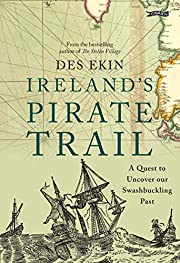Bokdetaljer
Forlag The OBrien Press
Utgivelsesår 2014
Format Heftet
ISBN13 9781847175984
Språk English
Sider 420
Finn boka på biblioteket
Finner du ikke ditt favorittbibliotek på lista? Send oss e-post til admin@bokelskere.no med navn på biblioteket og fylket det ligger i. Kanskje vi kan legge det til!
Bokomtaler
Des Ekin has studied the Spanish invasion of 1601 and its aftermath for years, and his new book, The Last Armada, makes a compelling case to re-evaluate what we think we know about the Battle of Kinsale.
“Too little, too late,” runs the conventional wisdom regarding the Siege of Kinsale in 1601. It’s what I remember being taught in school, and that’s almost all I could remember about this pivotal piece of history before I read Des Ekin’s fantastic book.
The Spanish sent a small fleet to aid the Irish O’Neill and O’Donnell chieftains in their long war against the English in the last years of Elizabeth I’s reign. Most historians consider the whole operation a fiasco: the force sent by Spain was too small, the choice of Kinsale appeared to be the wrong one, and the Irish forces move to link up with the Spanish came too late. In this version of events, the Irish forces were heroic, and their glorious rebellion undercut by incompetent or cowardly Spaniards.
First off all, Ekin paints vivid portraits of the principal combatants and the supporting players, revealing the influence of Catholic priests like Father James Archer and Franciscan monk Mateo de Oviedo at the Spanish court. Then he reveals that Kinsale one of several landing sites recommended by the Irish side. While bad weather played its part in preventing the Spanish fleet sailing up the West coast of Ireland towards some seemingly better choices, the choice of Kinsale was not a bad decision by the Spanish commander, Águila, as pro-Irish historians with propagandistic tendencies have often claimed.
The political background to the siege and climactic battle is brilliantly told, as Ekin unfolds the story of several men desperate for a successful campaign to reverse their fortunes.
The English Commander: Charles Blount
The English were commanded by Sir Charles Blount, Lord Mountjoy, who was tainted by his association with the Earl of Essex, Robert Devereux, whose attempted rebellion against Elizabeth I had ended in farce a year earlier. Blount was deeply distrusted by Robert Cecil, Elizabeth’s powerful Secretary-of-State, and kept his command in Ireland as much to keep him away from London as for his undoubted military skills. Elizabeth still carried a candle for him, but Cecil had him watched constantly.
The Irish Commander: Hugh O’Neill
The principal Irish chiefs were Hugh O’Neill and Red Hugh O’Donnell, who had waged successful guerilla campaigns against the English for years. While their tenacity and cunning had kept their forces largely intact, they lacked the skills, training, and degree of trust in each other to met the English in open battle. The mystery surrounding their decisions, first in delaying their move south in support of the Spanish, and later their strange actions in the final battle has been a source of controversy ever since. O’Neill’s actions after the defeat — trying to switch sides and ally with Blount against the Spanish — hardly fit his image as the great patriot.
The Spanish Commander: Juan del Águila
The Spanish were lead by General Juan del Águila, a general the whole of Europe held in high regard, but who had fallen afoul of court politics. It seems unlikely that the Spanish could have held Kinsale as long as they did without Águila’s knowledge and tenacity. After the siege had ended and Águila led his surviving forces back to Spain, he was court-marshaled due to the influence of the pro-Irish clerics and Red Hugh O’Donnell, who had fled Ireland immediately after the battle on Christmas Eve, 1601, and had been poisoning the court against Águila since his arrival. It long suited Irish propagandists to blame Águila for the defeat, and paint a picture of noble Gaelic lords betrayed by incompetent Spaniards, but Ekin details the full story of Águila’s court-marshall, and reveals that his military peers found his decisions correct, and remarkable given the paltry forces and limited supplies that that he had available to him.
As well as disposing of some mysteries and misinformation surrounding the siege and Battle of Kinsale, Ekin’s book also provides a remarkable look into the world of Elizabethan spies in Ireland and the infighting of different factions in the English and Spanish courts. Blount’s second-in-command was actually writing regular reports critical of him for Cecil. The priests with Águila, Oviedo and Archer, were constantly scheming and undermining Águila’s military decisions — in fact, they may have played decisive roles in both convincing the Spanish to mount the expedition, and the poor planning that likely doomed it before it began.
The Siege of Kinsale and the political changes that came about in its aftermath led directly to the flight of the Earls, the plantation of Ulster, and the treaty that partitioned Ireland and all the conflict that came afterwards. For such a pivotal event, the circumstances of the Spanish invasion of 1601 have been obscured in myth and propaganda for a long time. Des Ekin’s The Last Armada does a tremendous job uncovering the personalities, the political maneuvering, and the actions behind the myth, and reveals a dramatic and fascinating tale of 100 days which led to the death of the old Gaelic nobility.
atriptoireland.com / 2014
Skriv en omtale Se alle omtaler av verket
Diskusjoner om boka
Ingen diskusjoner ennå.
Start en diskusjon om verket Se alle diskusjoner om verketBokelskere som følger boka
1 bokelsker følger dette verket.
Se alle bokelskere som følger dette verketLister som inneholder dette verket
Her har jeg samlet flere bøker om fjern tid og hva som var "tillatt" da. Mye grusomheter som folk opplevde på kroppen samt nedlatenheter i den tidens samfunn. Fra Østen til vikinger. Nærmere i tid hvor seilskuter med kapret og mannskap tatt til fange og krevd løsepenger for. Slaveriskuter er også med, Norge deltok i dette gjennom unionen med Danmark.
Sjørøveri er et angrep på sjøfarende for å stjele gods eller skip, eller for å kreve løsepenger. En sjørøver, eller pirat, er en person som driver ulovlig virksomhet til sjøs, i motsetning til en kaper, som hadde tillatelse fra sin regjering til å angripe fiendtlige skip. Sjørøveri og kaperfart:
Sjørøveri:
Dette er ulovlig plyndring og angrep på skip til sjøs, utført av private, private skip, og har som mål å ta gods eller skip for egen vinning.
Kaperfart:
Dette er krigføring med private, bevæpnede fartøy som har fått kaperbrev fra en regjering. Disse fartøyene, kjent som kaperbåter eller kaperskip, har tillatelse til å angripe fiendtlige handelsskip som en del av en krig.
Misforståelser:
Mange av legendene og forestillingene om piratlivet kommer fra populærkultur som romaner og filmer, og inneholder ofte uhistoriske myter.
...
Unionen Danmark-Norge vedtok som det første land i verden en lov som forbød handel med slaver. Det skjedde i 1792. Brasil var det siste landet som innførte forbud mot slaveri, i 1888.
Bøker fra mitt bibliotek, ikke i kronologisk orden







